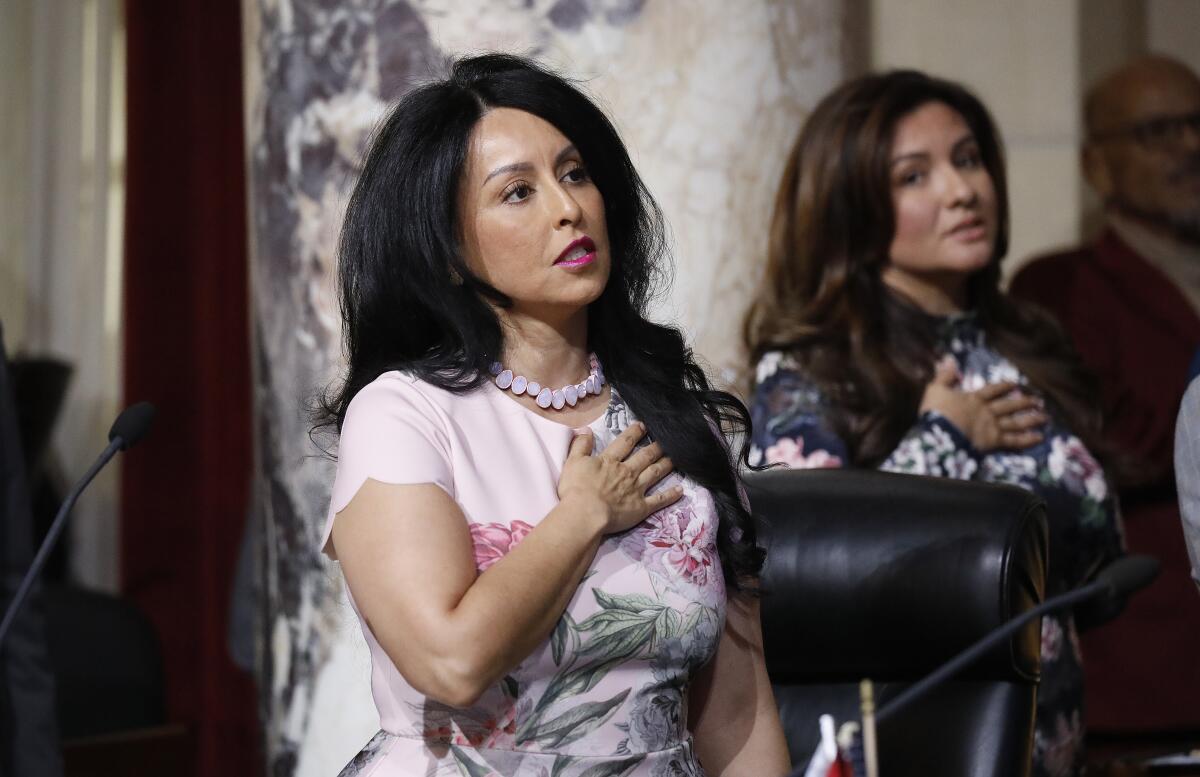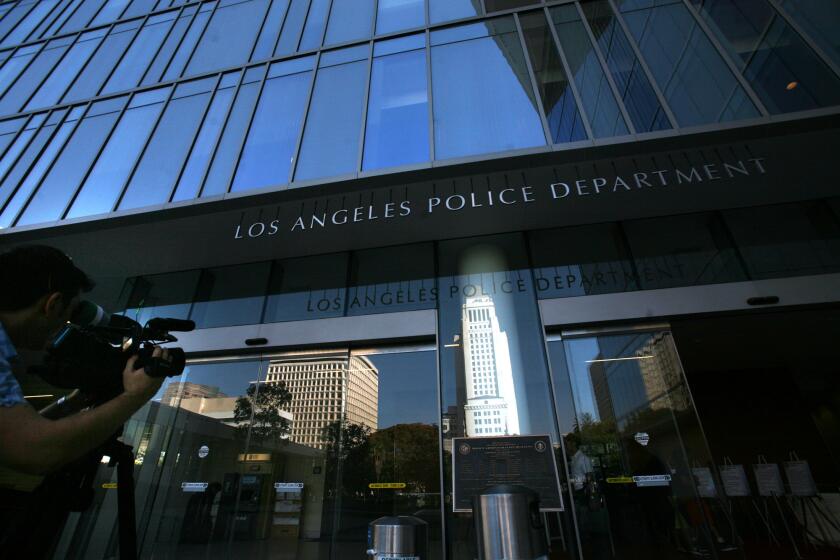L.A. vowed to cut police and help disenfranchised areas. Now that plan is under fire

- Share via
Six months ago, following massive protests over the death of George Floyd in Minneapolis, Los Angeles City Councilwoman Nury Martinez announced a dramatic step at City Hall: She and her colleagues would cut police spending by $150 million.
The plan, Martinez said at the time, would be to reinvest funding for vital services, including those that “uplift disenfranchised communities.”
On Wednesday, the council took its first stab at deciding where a chunk of that money — nearly $88.8 million — should go. So far, council members are looking to put much of the money toward nuts-and-bolts city services: street resurfacing, graffiti removal, alley cleanups and many other core city programs.
On a 13 to 2 vote, Martinez and her colleagues decided to focus the money on city services, youth and recreation programs, neighborhood beautification initiatives, job and business programs and nonprofit services. And while the final spending plan won’t be known until February, the list of potential projects offered so far by council members is already drawing fire.
The list of proposals, which is still subject to change, included street sweeping, new curb ramps, storm drain improvements, exercise equipment for parks, new landscaping for medians, left-turn signals and tree stump removal.
“We got this promise of reinvesting in communities of color,” said Rob Quan, an organizer with Unrig L.A., which seeks to promote representative government and fight corruption. “And all we really got was ... glorified pork barrel spending.”
Asked about Quan’s criticism, Martinez issued a statement saying the program is “one small step of many” needed to make the city more equitable.
Angelenos largely approve of the LAPD, but they also support Black Lives Matter and want to see some funding shifted, a Loyola Marymount study finds.
Martinez said she heard the call for change this year from “disenfranchised communities of color,” both locally and nationally. Under the program, the greatest share of the money will go to districts with the greatest number of census tracts experiencing poverty and unemployment.
“We listened to our Black and brown communities as they asked for more resources — the same resources they see in affluent communities and are easy to take for granted unless you’ve had to push a stroller through dirt in the dark, unless you live in a garage and your kids rely on parks as their only play space,” she said.
Martinez, who represents part of the San Fernando Valley, proposed using some of the reprogrammed LAPD money for speed humps, street sweeping, tree trimming and traffic signals, as well as arts, sports and tutoring programs for youth in her district, according to the city’s report.
Still, some on the council questioned the wisdom of embarking on new spending initiatives when hundreds of workers — many of them Black or Latino — are at risk of being laid off as the city works to close an estimated $675-million budget deficit.
Councilman Bob Blumenfield called the strategy “bizarre,” saying that, while underserved neighborhoods need more support, the city should also work to keep city employees from being pushed into unemployment.
“It’s like we’re creating these funds to build sidewalks in areas that have been less served, but we’re cutting the people who build the sidewalks,” said Blumenfield, one of two council members who opposed the spending strategy.
Councilman Mike Bonin voted in favor of the plan but also sounded disappointed, saying this week that the program “doesn’t quite deliver the punch we had hoped.”
“It’s important stuff — I mean, slurry sealing the street is important. Trimming the trees is important,” he said. “But it seems kind of nickel and dime for something that was meant to be such a big promise.”
Bonin, during a recent budget hearing, expressed disappointment that the funds won’t go toward “reimagining public safety,” the effort to move certain duties out of the LAPD, such as traffic enforcement or responses to people having mental health crises.
Alexis Wesson, a policy aide to Martinez, told council members that effort is under way but proceeding on a separate track.
City Administrative Officer Rich Llewellyn, the city’s top budget analyst, said he recommended that the council focus the $88.8 million on one-time projects, in part because the city is in a budget crisis and may not have funding to continue the programs in the following fiscal year.
“The real goal here was to get a list of projects that could be done and could be done expeditiously,” Llewellyn told the council’s budget committee.
Martinez and her colleagues announced the plan to cut LAPD spending in June, after demonstrations demanding an end to police brutality and a defunding of the police. Mayor Eric Garcetti embraced the $150-million reduction that day, discussing his support for the concept during a live television briefing.
Council members formally approved the $150-million cut in July, spurring the Police Department to slash overtime pay and reduce deployment to 9,757 officers by June 2021 — the lowest amount since 2008. The council also used some of the money to address the city’s financial crisis, putting $40 million into a fund to delay furloughs — then envisioned as a 10% pay cut for civilian city workers — and setting aside $10 million for the city’s reserve.
Another $10 million was earmarked for jobs programs.
The remainder of the money cut from the LAPD will be carved up by council district, with the greatest share going to areas with the greatest need. Under that strategy, nearly $50 million would be distributed to three of the council’s 15 districts, all of which take in portions of South Los Angeles.
The management of an extended-stay Studio 6 motel in Commerce locked out formerly homeless residents even as L.A. County was buying the property to house homeless people.
The biggest share, $21.1 million, would go to the district represented by Councilman Curren Price, which stretches from the city’s Convention Center south to 95th Street.
Price signaled an interest in using the money for youth arts programs and hiring initiatives for youths and those who were previously incarcerated, according to the council’s report.
Councilman Marqueece Harris-Dawson, whose district would receive $16.6 million, also put hiring programs on his potential spending list. But he also proposed park improvements, street and alley resurfacing, tree trimming, parking enforcement, illegal dumping investigations and other initiatives, the report said.
The plan for the money has drawn criticism from Police Chief Michel Moore, who argued that public works projects, while valid, should not take priority over public safety at a time when homicides and the number of shooting victims are sharply increasing.
The union that represents rank-and-file police officers went even further, accusing council members of cutting LAPD staffing so they can have a slush fund for their districts.
“Laying off hundreds of police officers to fund curb cuts, landscaping, and tree stump removals in the name of public safety is absurd,” said Craig Lally, president of the Los Angeles Police Protective League, the union representing roughly 9,800 LAPD officers. “Murders and shootings have surged to a 10-year high, and no one suffers the bloodshed more than our most economically disadvantaged neighborhoods.”
Asked about the union’s assertions, Price said the council’s decision demonstrated “a firm and ongoing commitment to equity and social justice.”
Price said cutting the LAPD budget will free up money for additional gang intervention workers in his district, who will work to reduce crime and save lives. The extra funds will also allow for more homeless outreach teams, he said.
“This presents a tremendous opportunity to elevate communities like the one I represent, that suffer much of the brunt of despair felt during these perilous times in our city,” Price said in an emailed statement.
Times staff writer Kevin Rector contributed to this report.
More to Read
Sign up for Essential California
The most important California stories and recommendations in your inbox every morning.
You may occasionally receive promotional content from the Los Angeles Times.














